Last updated on May 8th, 2025 at 01:58 pm
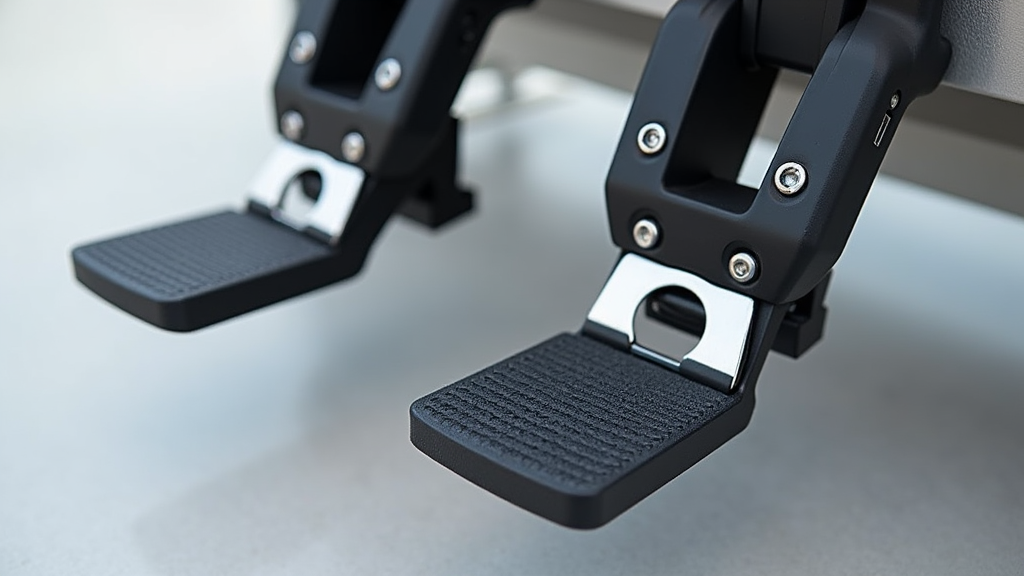
While I haven’t used rudder pedals myself (yet), I’ve spent a lot of time researching and watching real user reviews to understand how they impact the overall flight sim experience. Based on what I’ve seen—especially when paired with a quality joystick—rudder pedals add a whole new level of control and realism. It’s definitely something I plan to explore further once I upgrade to a gaming laptop.
In my experience, selecting the right pedals is not simply a matter of preference. The pedals play an important role in controlling the yaw of the aircraft. They are essential during taxiing, coordinated turns, and crosswind landings. A well-chosen setup can significantly improve the realism and precision of your simulator experience.
Why Rudder Pedals Matter in Flight Simulation

Rudder pedals give you control over an aircraft’s yaw—basically, its side-to-side motion. In real-world flying, they’re essential for things like taxiing, making coordinated turns, and handling crosswinds. In a simulator, they help recreate that same feeling. From my own experience, adding rudder pedals makes the whole setup feel more complete and gives your flying much more precision and realism.
The pedals are responsible for subtle movements that help coordinate turns and counteract adverse effects like crosswinds. In essence, they add a significant layer of depth to your flight simulator experience by imitating real-world controls. If you’re just beginning to explore flight simulation, be sure to check out our Getting Started With Flight Simulation: A Step-by-Step Guide.
Match Pedals to the Type of Aircraft You Fly
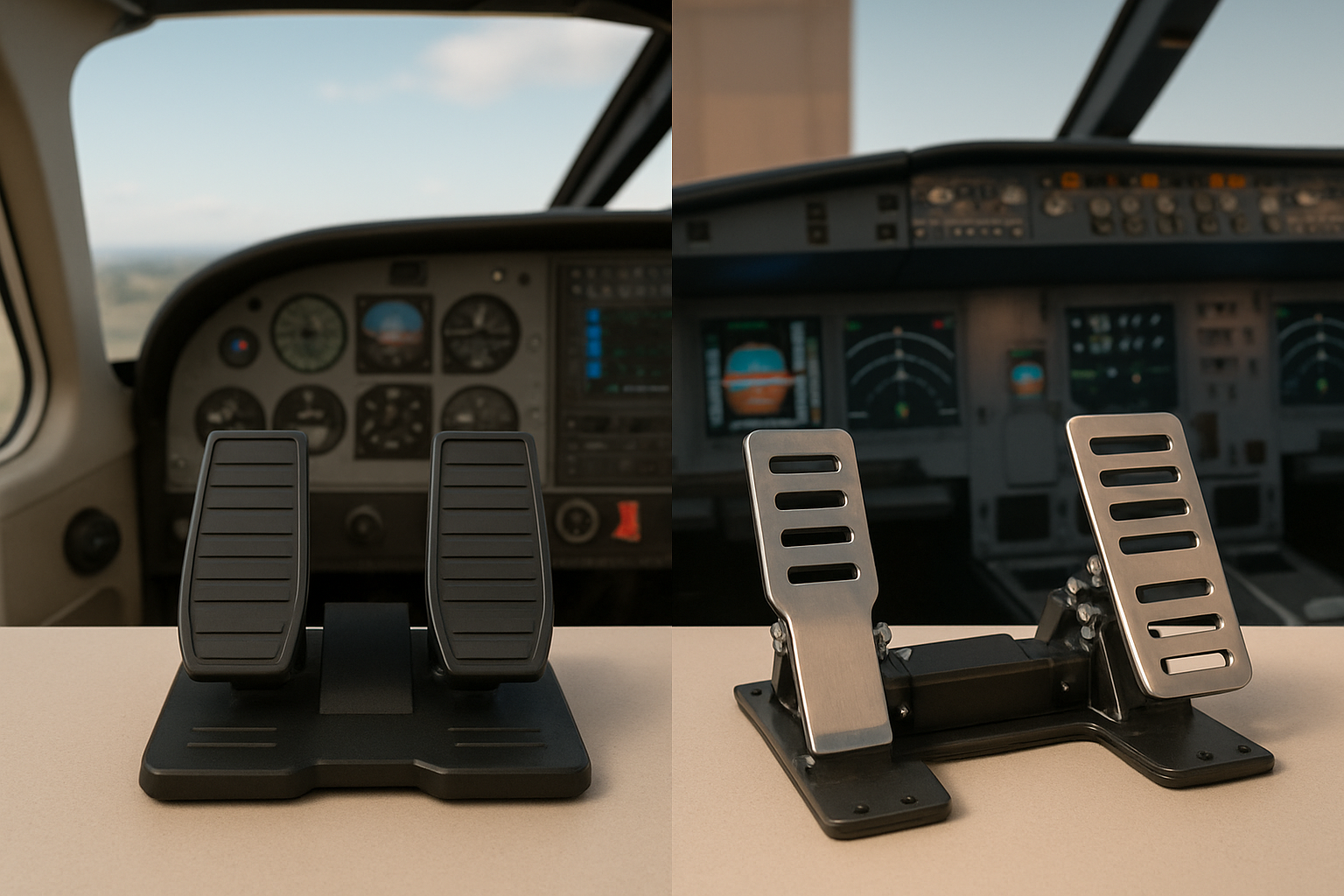
Aircraft differ in how they use rudder control. It is important to consider the type of aircraft you plan to simulate. Different aircraft require varying levels of sensitivity and control. My approach is to match the pedal type with the simulator type to achieve a more realistic feel.
General Aviation and Airliners
- The focus should be on smooth, linear movement.
- Responsiveness should be moderate to ensure realistic control during taxiing and gradual turns.
Combat or Fighter Jets
- Pilots usually appreciate pedals with fast response times.
- Precision in toe brake control is important, as it simulates the high demands of combat maneuvers.
Not all aircraft handle the same way—and your pedals shouldn’t either. If you’re flying general aviation or airliners, look for pedals with smooth, consistent motion. For fighter jets or military aircraft, quicker response and tighter control might be better. I’ve found that matching the feel of your pedals to your aircraft type really makes a difference, especially during turns or ground handling.
Compatibility with Your Simulator Setup
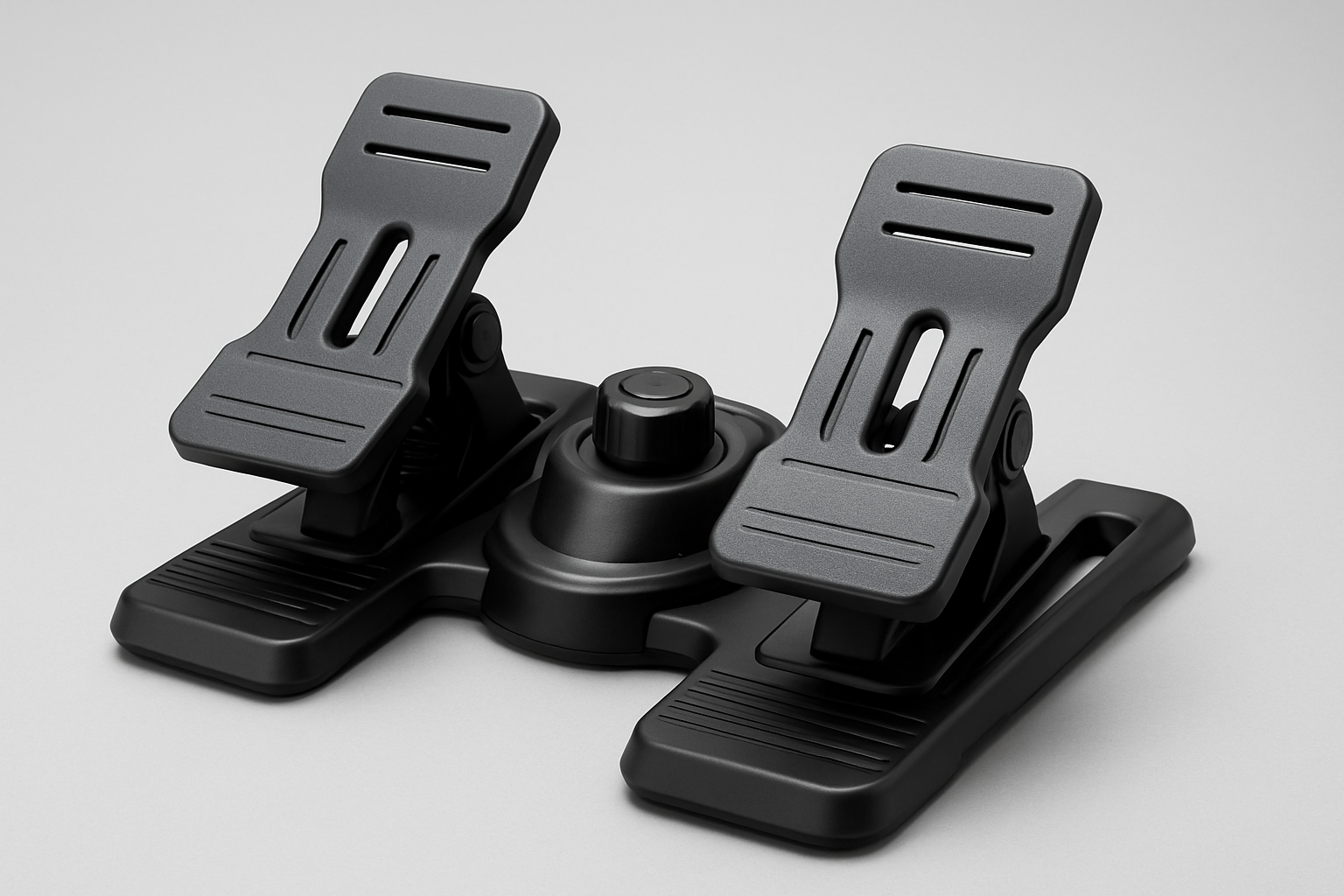
When researching rudder pedals, I always make sure to check their compatibility with various simulator platforms. Whether you’re using a PC, Mac, or a console like Xbox, it’s important that the pedals work smoothly with your setup. Compatibility details are usually listed in the product specs or mentioned in user reviews. Some rudder pedals are easily plug and play, while others might require driver installation or software adjustments. Most popular rudder pedals are compatible with simulators like Microsoft Flight Simulator, X-Plane, and Prepar3D.
It is also wise to review the supported simulator software. Options like Microsoft Flight Simulator, X-Plane, and Prepar3D each have their own requirements. Ensuring compatibility avoids potential technical issues and lets you focus on your flight experience right away. Not all simulators are created equal—learn more about choosing the right flight simulator for your needs.
Build Quality and Materials
Durability is an important aspect of any simulator component, especially rudder pedals that see heavy use. In my search, I often compare models made of metal versus those constructed with reinforced plastic. Metal pedals often offer long life and greater resistance to wear, while reinforced plastics can provide an option for those with budget constraints.
Key factors I consider include robust construction and stability. I also look for features such as an anti-slip base and adjustable tension. These features ensure the pedals remain secure during use and can adapt to different levels of force.
Adjustable Features for Comfort
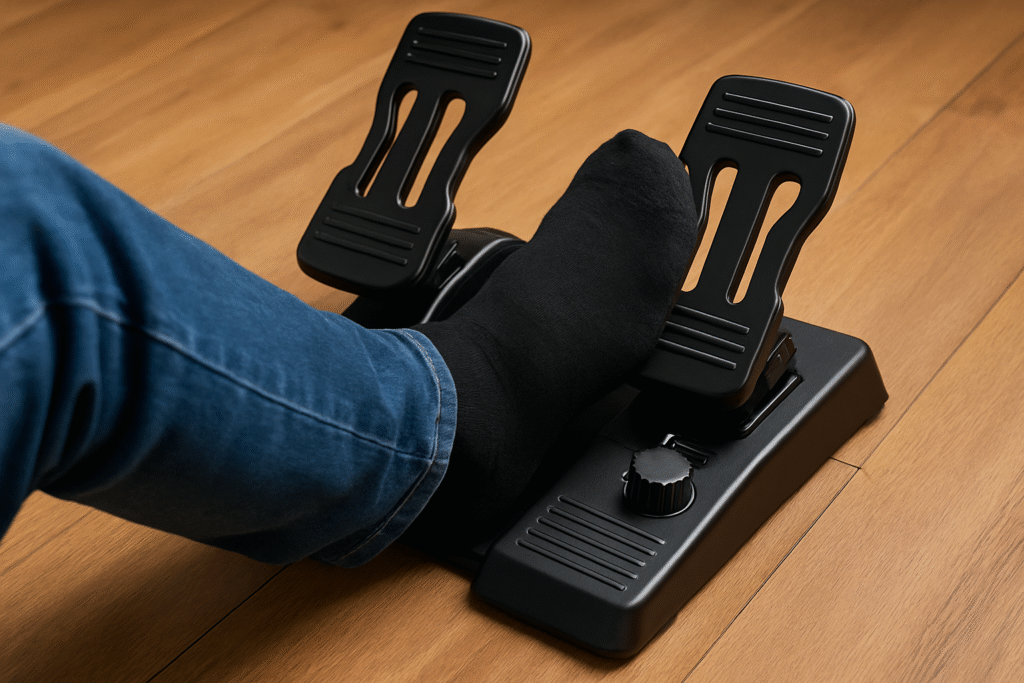
Comfort is key when investing in rudder pedals for extensive simulator sessions. I have learned that pedals with adjustable features can provide a better experience, particularly over long periods of use. These features help you find a posture that is less fatiguing, no matter your physical build or how long you fly.
Customization Options
- Adjustable pedal angles are essential for aligning controls with your seating position.
- Spacing customization helps accommodate different foot sizes.
- Tension adjusters allow you to set realistic resistance, mimicking the feel of real aircraft controls.
A setup that allows these customizable adjustments leads to both comfort and accuracy. It helps you enjoy longer sessions without discomfort and ensures you have the right level of responsiveness during flight.
Smoothness and Precision
Selecting pedals with smooth mechanical operation can greatly give a boost to your simulator experience. The difference between sensors influences performance. I tend to favor pedals that use hall-effect sensors instead of traditional potentiometers. Hall-effect sensors are known for their precision and reduced wear.
These sensors operate using magnetic fields and offer a smoother response. This means that even with extensive use, the performance remains consistent. The increased accuracy allows for tighter control during critical phases such as landing or executing sharp turns. Look for pedals that incorporate hall-effect sensor technology for smoother operation. These magnetic sensors offer precise and long-lasting performance compared to traditional potentiometers.
Precision in rudder control is very important for both beginner pilots and advanced users who value accuracy above all else. To understand how yaw control contributes to coordinated flight, explore the basics of aerodynamics in simulators.
Toe Brakes Integration

Many rudder pedals include toe brakes, which are very useful for simulating realistic taxiing and landing rolls. In my experience, pedals that offer analog toe brakes tend to perform better in a variety of scenarios. These provide independent control for each side and add to the realism, especially when simulating ground maneuvers.
When considering this feature, it is important to look at how well the pedal isolates brake function from rudder input. Pedals that separate these functions give you more control, making them ideal for flight modes where precise braking is essential.
For both general aviation and advanced flight training simulators, having a toe brake option can complete the realistic experience.
Think Long-Term Value, Not Just Price
Cost can vary widely when it comes to rudder pedals. It is very important for me to consider not just the sticker price, but the overall value. Rudder pedals come in a wide price range—from entry-level models to high-end, professional-grade setups. But it’s not just about price; it’s about what you’re getting for your money. In my experience, a more expensive set can often save you money in the long run by lasting longer and offering better performance. I always recommend looking at real user reviews and comparing features before hitting buy. If you’re just getting started, here are the top beginner-friendly simulators that pair well with entry-level rudder pedals.
Trusted Brands and Resources
** Please note: This post contains affiliate links. As an Amazon Associate, I earn from qualifying purchases at no extra cost to you.
Based on my experiences and research, a few brands frequently surface when discussing reliable rudder pedals. These manufacturers have built a reputation for quality and performance in the simulator community. Communities like Reddit’s flight sim community offer great insight and real-world feedback from other users.
Brand Options to Consider
- Thrustmaster TFRP Rudder Pedals
If you’re just getting into flight simulation, the TFRP pedals are a great starting point. They’re beginner-friendly, relatively affordable, and offer a solid introduction to rudder control. While they don’t have advanced features like high-end models, they’re responsive and smooth enough for casual flyers or anyone learning the ropes. - Logitech G Pro Flight Rudder Pedals
A solid mid-range choice, these pedals strike a nice balance between performance and price. The adjustable tension dial helps you customize how they feel, and the smooth sliding action makes them great for a wide range of aircraft types. They’re dependable, easy to set up, and offer good value for sim pilots who want more realism without going all in on a premium setup. - Thrustmaster TPR Rudder Pedals
Looking for professional-grade realism? The Thrustmaster TPR pedals are where things get serious. With HallEffect AccuRate Technology, adjustable pedal angles, and industrial-grade construction, these pedals deliver incredibly precise input and a solid, grounded feel. They’re ideal for serious sim pilots who want that authentic, cockpit-like control. It’s a big investment—but one that pays off in accuracy and immersion.
Before purchasing, I always check out reviews and demo videos. YouTube is a useful resource for checking out product demonstrations and getting an overall sense of the pedal’s performance. Additionally, forums like AVSIM and communities on Reddit allow enthusiasts to ask questions and share insights. The feedback from these communities can help avoid potential issues and confirm that your choice aligns with your simulation goals.
Additional Accessories for an Immersive Experience
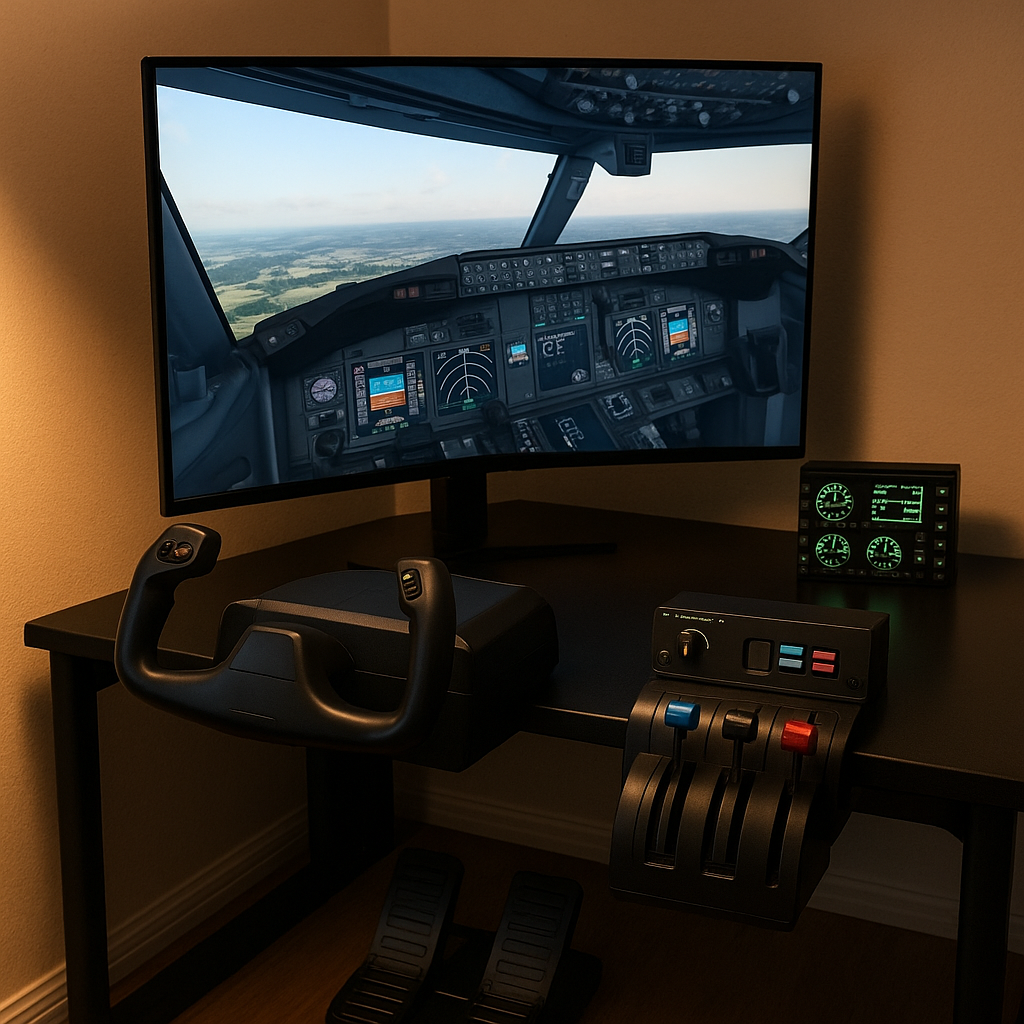
To truly level up your flight simulator setup, it can be very beneficial to consider additional accessories. Many users find that integrating components such as throttles, yoke controls, and even advanced multi-display setups help create a more complete and responsive environment. By mixing in some variety and exploring complementary devices, you can create a cockpit that is not only functional but also next-level cool in its appearance and performance.
Furthermore, supplementary controls like dedicated radio panels or instrument displays add another layer of depth. These items help fill in the gaps by providing essential flight information at a glance. When you team up these tools with your rudder pedals, your virtual cockpit becomes an all-in-one, highly detailed replica of a real-world aircraft. Taking these extra steps can make the simulator experience feel remarkably cohesive and more rewarding overall. For even more realism, consider pairing your pedals with a quality joystick to complete your cockpit.
Common Questions and Troubleshooting
When it comes to rudder pedals, several questions often come up. Based on my experience and observations from other enthusiasts, here are some common concerns and suggestions.
Will the pedals work with my simulator setup?
It is important to review the technical specifications. Look for compatibility details related to the simulator software and hardware platforms. If you have any issues, checking for software updates or contacting customer support can be useful.
What if the pedals do not feel responsive enough?
- Check if the tension adjusters are properly configured to match the force you need.
- Experiment with sensor calibration in your simulator settings.
- Consider a model with hall-effect sensors if you are using potentiometer-based pedals.
- If you’re experiencing trouble not listed here, it’s a good idea to check the user manual or search online forums, Google, or YouTube for troubleshooting tips specific to your pedal model. If none of that works and the pedals still don’t perform properly, consider requesting a refund or replacement—especially if you ordered from Amazon or another reputable seller.
Do I really need toe brakes?
If you value features such as realistic taxiing and braking during landing, I recommend pedals with integral toe brakes. They add a layer of realism that can be especially beneficial for simulating detailed flight protocols. When your simulator setup supports analog toe brakes, you gain finer control over your maneuvers.
For those primarily interested in flight training or high-fidelity experiences, the integration of toe brakes is a worthwhile consideration.
Wrapping Up – Take Your Time Choosing
Picking the right rudder pedals isn’t just about specs—it’s about finding the setup that fits your flying style and goals. From sensor type to build quality and comfort, every detail adds up. If you’re aiming for a more realistic, immersive experience, investing in the right gear is well worth it. Take your time, do your research, and enjoy the process—your virtual flying will feel all the better for it.
When evaluating options, consider the following steps:
Your Action Plan
- Determine what type of aircraft you will simulate most often. This will guide your decision on the pedal movement and response required.
- Verify that the pedals are compatible with your hardware and software. Check for USB plug-and-play or additional driver requirements to avoid compatibility issues.
- Examine the build quality and available adjustable features. Decide if metal construction or reinforced plastic fits your needs better, then assess the options for customizing pedal angle and tension.
- Look for pedals that incorporate hall-effect sensor technology for smoother operation. The precision of these sensors can make a significant difference during demanding simulation scenarios.
- Decide whether integrated toe brakes are important to your simulator experience. If so, prioritize models that offer this additional functionality.
- Check out rudder pedal video reviews on YouTube to see how different models perform before making a purchase.
- Research trusted brands by checking in on user feedback from platforms like Reddit’s flight sim community. Real-life user experiences can help confirm that the product meets your expectations.
Once you have gathered all the necessary information, you are in a good position to choose the rudder pedals that best match your simulator setup. With the right tools, you can enjoy an immersive flight experience that brings training and entertainment closer to real-life aviation.
What will you consider the most important feature when selecting rudder pedals for your simulator? The right choice could greatly improve your control and overall simulation performance. Taking the time to research and test different options is really important and may make all the difference in your virtual cockpit setup.

HELLO, I was very intrigued with this article. I,very much desire to get a flight simulator for myself and my son who is in the reserves. Of course, I would have to go to your “Getting Started With Flight Simulation , A Step By Step Guide” page first. And I will. This article mentions that one must consider “…the type of aircraft you plan to simulate.” I did not realize there is that kind of choice. So, we can choose between a fighter jet simulator or a commercial jet simulator? What about a crop duster simulator? Also, your article mentions simulator platforms like Xbox, PC and MAC. I do have a MAC laptop that I can probably use but I would rather use the larger TV screen. I have the Playstation 4 connected to my TV. Would that be suitable for a flight simulator?
So, I think I will go to your getting started page next, then I will go to the “Top 5 Beginner – Friendly Flight Simulators – Your Gateway to Virtual Aviation” page, or should it be vice a versa? Well I will check out those two pages next and then we will go from there. thank you for this inspiring article. I hope to make decisions soon. MAC.
Hi Michael
Thank you so much for your thoughtful comment—I’m really glad the article resonated with you! It’s fantastic that you’re considering flight simulation as something to enjoy with your son—that’s such a meaningful way to spend time together.
You’re absolutely right—there are many types of aircraft you can simulate, from fighter jets and commercial airliners to bush planes and yes, even crop dusters in some sim add-ons! It really depends on what kind of flying experience you’re after.
As for your setup, Microsoft Flight Simulator isn’t available on Mac or PlayStation unfortunately. But you’re in luck—X-Plane 12 works on Mac and offers a great range of aircraft and realism. If you’re considering using a TV screen for a larger display, connecting your Mac to the TV via HDMI could work well.
You mentioned the “Getting Started” and “Top 5 Beginner-Friendly Simulators” pages—both are great next steps. I’d suggest starting with the Getting Started Guide to get an overview, then head to the Beginner Simulators list to find one that fits your setup and goals.
Feel free to reach out if you have any other questions—I’m happy to help you get airborne!
Dear MElamin,
Thank you for your insightful article on selecting the right rudder pedals for flight simulators. Your comprehensive breakdown of factors like sensor types, build quality, and the inclusion of toe brakes provides valuable guidance for both novice and seasoned virtual pilots. I particularly appreciated your emphasis on aligning pedal choice with one’s specific flying style and goals, which is often an overlooked aspect in many guides
Considering the rapid advancements in simulation technology, have you explored the impact of load cell sensors on pedal performance? Many enthusiasts suggest that load cells offer enhanced precision and realism compared to traditional potentiometers. It would be interesting to hear your thoughts on this and whether you believe the investment in load cell-equipped pedals is justified for most users.
Looking forward to more of your expert insights on flight simulation accessories!
Sincerely,
Steve
Hi Steve,
Thank you for the kind words and for taking the time to share your thoughts! I’m glad you found the guide helpful.
As for your question about load cell sensors—I haven’t personally used rudder pedals equipped with them yet, but I’ve definitely heard from others in the community that they offer more precise and realistic control, especially during critical maneuvers like crosswind landings or taxiing. From what I’ve gathered, the improved responsiveness compared to potentiometer-based pedals could make a big difference for those looking to take their sim experience to the next level.
I think for serious sim enthusiasts, especially those flying regularly or practicing advanced techniques, the investment in load cell-equipped pedals might be worth considering.
Thanks again for your thoughtful comment—really appreciated!
Really appreciate this thorough breakdown of rudder pedals! Even without firsthand experience, your research shines through and makes it clear how important they are for adding realism to flight simulators. It’s interesting how they’re crucial for things like taxiing and crosswind landings — details that really take the sim experience to the next level. Definitely inspired me to consider investing in a quality set once I’m ready to upgrade my setup. Thanks for sharing your insights
Hi kjf390,
I’m really glad to hear you enjoyed the article on rudder pedals! You’re absolutely right — they make a big difference when it comes to realism, especially during taxiing, crosswind landings, and more nuanced maneuvers.
When you’re ready to upgrade, I definitely recommend taking some time to research which set fits your setup and flying style best. User reviews and community feedback can be super helpful in narrowing down the right choice. Feel free to reach out if you ever want suggestions based on aircraft type or budget!
Happy flying,